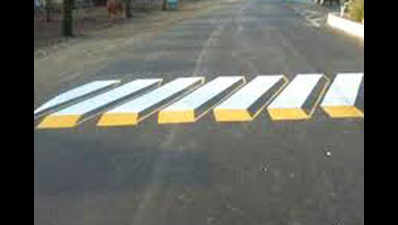- News
- City News
- delhi News
- Illusion that works: 3D way to curb accidents
Trending
This story is from June 9, 2016
Illusion that works: 3D way to curb accidents
With India accounting for 11% of road-accident deaths in the world, there's an urgent need to reduce pedestrian fatalities.

Representative image.
New Delhi: With India accounting for 11% of road-accident deaths in the world, there's an urgent need to reduce pedestrian fatalities. Recently, the ministry of road transport and highways asked CSIR-CRRI to conduct a study on the efficacy of three-dimensional zebra crossings in the city. According to the study, the 3D zebra crossing showed excellent results for heavy commercial vehicles, such as trucks and buses, while the impact was not so great on small cars.
CSIR-CRRI recommended marking all entry and exit points on national highways with 3D paint to further monitor the reduction in vehicle speeds over a year. Dr Kayitha Ravinder, who carried out the study under the supervision of CSIR-CRRI director Satish Chandra, said: "The idea was to see how effective such a crossing was and whether it could be used in areas close to schools, colleges and in accident-prone locations."
The study noted and analysed spot speeds of various categories of vehicles, both before and after the crossing came up. The reduction in speed of different types of vehicles was found to vary between 1.6% and 20.3%, said Dr S Velmurugan, who was also part of the team that undertook the study.
The minimum speed reduction -- of about 1.6% -- was observed in small cars (up to 1400 cc). The maximum speed reduction of 20.3% was seen in the case of heavy commercial vehicles. "The reason was the vantage viewing height of HCVs and buses, which is more, making the 3D marking laid across the road conspicuous from such a height. Consequently, statistically significant speed reduction was observed."
The actual spotting, or visualisation, of the 3D marking was found to be more efective during the lean hours of traffic flow. It was found 3D zebra crossings with conventional enamel paint dissipated fast. A 3D paint, which has been invented by Saumya Pandya Thakkar and Shakuntala Pandya of Ahmedabad, was used in the experiment by CSIR-CRRI. The report said the 3D marking "should find a place in the Indian Road Congress document, Code of Practice for Road Markings IRC:35 (2015), to gain acceptability at national level before putting to effect on Indian roads".
CSIR-CRRI recommended marking all entry and exit points on national highways with 3D paint to further monitor the reduction in vehicle speeds over a year. Dr Kayitha Ravinder, who carried out the study under the supervision of CSIR-CRRI director Satish Chandra, said: "The idea was to see how effective such a crossing was and whether it could be used in areas close to schools, colleges and in accident-prone locations."
The study noted and analysed spot speeds of various categories of vehicles, both before and after the crossing came up. The reduction in speed of different types of vehicles was found to vary between 1.6% and 20.3%, said Dr S Velmurugan, who was also part of the team that undertook the study.
The minimum speed reduction -- of about 1.6% -- was observed in small cars (up to 1400 cc). The maximum speed reduction of 20.3% was seen in the case of heavy commercial vehicles. "The reason was the vantage viewing height of HCVs and buses, which is more, making the 3D marking laid across the road conspicuous from such a height. Consequently, statistically significant speed reduction was observed."
The findings recommended that 3D zebra crossings be coloured with thermoplastic paint at all accident-prone locations in urban and peri-urban areas and monitored.
The actual spotting, or visualisation, of the 3D marking was found to be more efective during the lean hours of traffic flow. It was found 3D zebra crossings with conventional enamel paint dissipated fast. A 3D paint, which has been invented by Saumya Pandya Thakkar and Shakuntala Pandya of Ahmedabad, was used in the experiment by CSIR-CRRI. The report said the 3D marking "should find a place in the Indian Road Congress document, Code of Practice for Road Markings IRC:35 (2015), to gain acceptability at national level before putting to effect on Indian roads".
End of Article
FOLLOW US ON SOCIAL MEDIA










